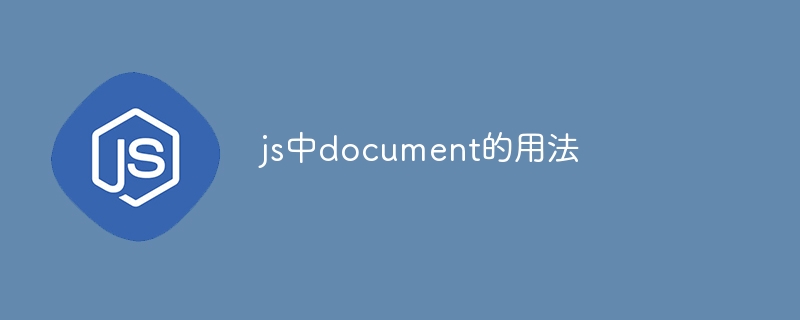How to use document in js
Document is a global object in JavaScript used to interact with HTML documents. The main uses include: Obtaining and modifying DOM elements Listening for events and handling user interaction Accessing page metadata Storing and retrieving data Usage: The document object is a global variable and can be used directly. Attributes include documentElement, body, head, cookie, location, title. The main methods include getElementById, getElementsByTagName, createElement, addEventListener, removeEve

##Usage of document in JavaScript
document object Is a JavaScript global object provided by the browser, which represents the currently opened HTML document. It provides a set of methods and properties for interacting with the DOM (Document Object Model) to perform operations such as page manipulation, form validation, or handling user interaction.Main purpose:
- Get and modify DOM elements
- Listen to events and handle user interactions
- Access page elements Data (such as title, URL)
- Storage and retrieval of data (via cookie, localStorage)
Usage:
document object automatically Becomes a global variable for all browser windows. Therefore, you can use it directly like this:document.getElementById("myElement").innerHTML = "Hello World!";Main attribute:
- documentElement: Points to the root element of the HTML document ( html).
- body: Points to the body element (body) of the HTML document.
- head: Points to the head element (head) of the HTML document.
- cookie: A string containing the cookie for the current page.
- location: Provides information about the current page URL and location.
- title: Get or set the title of the page.
Main method:
- getElementById(id): Get the element in the page based on its ID.
- getElementsByTagName(name): Get all matching elements in the page based on their names.
- createElement(element): Create a new element.
- addEventListener(event, listener): Listen to specific events on elements.
- removeEventListener(event, listener): Remove the event listener.
- querySelector(selector): Use CSS selector to get elements in the page.
- querySelectorAll(selector): Use a CSS selector to get all matching elements in the page.
The above is the detailed content of How to use document in js. For more information, please follow other related articles on the PHP Chinese website!

Hot AI Tools

Undresser.AI Undress
AI-powered app for creating realistic nude photos

AI Clothes Remover
Online AI tool for removing clothes from photos.

Undress AI Tool
Undress images for free

Clothoff.io
AI clothes remover

AI Hentai Generator
Generate AI Hentai for free.

Hot Article

Hot Tools

Notepad++7.3.1
Easy-to-use and free code editor

SublimeText3 Chinese version
Chinese version, very easy to use

Zend Studio 13.0.1
Powerful PHP integrated development environment

Dreamweaver CS6
Visual web development tools

SublimeText3 Mac version
God-level code editing software (SublimeText3)

Hot Topics
 1384
1384
 52
52
 The Roles of HTML, CSS, and JavaScript: Core Responsibilities
Apr 08, 2025 pm 07:05 PM
The Roles of HTML, CSS, and JavaScript: Core Responsibilities
Apr 08, 2025 pm 07:05 PM
HTML defines the web structure, CSS is responsible for style and layout, and JavaScript gives dynamic interaction. The three perform their duties in web development and jointly build a colorful website.
 How to use bootstrap in vue
Apr 07, 2025 pm 11:33 PM
How to use bootstrap in vue
Apr 07, 2025 pm 11:33 PM
Using Bootstrap in Vue.js is divided into five steps: Install Bootstrap. Import Bootstrap in main.js. Use the Bootstrap component directly in the template. Optional: Custom style. Optional: Use plug-ins.
 How to write split lines on bootstrap
Apr 07, 2025 pm 03:12 PM
How to write split lines on bootstrap
Apr 07, 2025 pm 03:12 PM
There are two ways to create a Bootstrap split line: using the tag, which creates a horizontal split line. Use the CSS border property to create custom style split lines.
 How to resize bootstrap
Apr 07, 2025 pm 03:18 PM
How to resize bootstrap
Apr 07, 2025 pm 03:18 PM
To adjust the size of elements in Bootstrap, you can use the dimension class, which includes: adjusting width: .col-, .w-, .mw-adjust height: .h-, .min-h-, .max-h-
 How to set up the framework for bootstrap
Apr 07, 2025 pm 03:27 PM
How to set up the framework for bootstrap
Apr 07, 2025 pm 03:27 PM
To set up the Bootstrap framework, you need to follow these steps: 1. Reference the Bootstrap file via CDN; 2. Download and host the file on your own server; 3. Include the Bootstrap file in HTML; 4. Compile Sass/Less as needed; 5. Import a custom file (optional). Once setup is complete, you can use Bootstrap's grid systems, components, and styles to create responsive websites and applications.
 How to insert pictures on bootstrap
Apr 07, 2025 pm 03:30 PM
How to insert pictures on bootstrap
Apr 07, 2025 pm 03:30 PM
There are several ways to insert images in Bootstrap: insert images directly, using the HTML img tag. With the Bootstrap image component, you can provide responsive images and more styles. Set the image size, use the img-fluid class to make the image adaptable. Set the border, using the img-bordered class. Set the rounded corners and use the img-rounded class. Set the shadow, use the shadow class. Resize and position the image, using CSS style. Using the background image, use the background-image CSS property.
 Understanding HTML, CSS, and JavaScript: A Beginner's Guide
Apr 12, 2025 am 12:02 AM
Understanding HTML, CSS, and JavaScript: A Beginner's Guide
Apr 12, 2025 am 12:02 AM
WebdevelopmentreliesonHTML,CSS,andJavaScript:1)HTMLstructurescontent,2)CSSstylesit,and3)JavaScriptaddsinteractivity,formingthebasisofmodernwebexperiences.
 How to use bootstrap button
Apr 07, 2025 pm 03:09 PM
How to use bootstrap button
Apr 07, 2025 pm 03:09 PM
How to use the Bootstrap button? Introduce Bootstrap CSS to create button elements and add Bootstrap button class to add button text




